Malcolm R. Campbell's Blog, page 187
October 16, 2016
Florida Legends: The man who could turn into an alligator
One of my favorite stories out of the Federal Writers Florida Folklore project, is the one about Uncle Monday collected by the author Zora Neale Hurston in the 1930s. Among other places, it appears in “Uncle Monday and Other Florida Tales” by Kristin G. Congdon.
Uncle Monday was a powerful conjure man who brought his magic from Africa. He was sold into slavery. When he escaped, he joined up with the Seminole Indians to fight against federal troops. He vowed that he would never be taken captive and enslaved again.
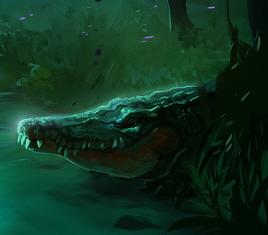 During a ceremony at Blue Sink Lake in central Florida held by Africans and Indians, Uncle Monday danced and transformed into an alligator and plunged into the lake with all the other alligators. He is said to live there even now and to change into a man again when it suits his fancy. At the end of the day, though, he returns to the lake and, as Congdon writes in her rendition, folks “feel more comfortable with Uncle Monday home in the waters with his reptile family.”
During a ceremony at Blue Sink Lake in central Florida held by Africans and Indians, Uncle Monday danced and transformed into an alligator and plunged into the lake with all the other alligators. He is said to live there even now and to change into a man again when it suits his fancy. At the end of the day, though, he returns to the lake and, as Congdon writes in her rendition, folks “feel more comfortable with Uncle Monday home in the waters with his reptile family.”
If you search on line, you’ll probably find a number of tales about the alligator man, one of which relates the story of one Judy Bronson of Maitland who claimed she was a more powerful conjure doctor than anyone else. One night when she was fishing at Blue Sink, she saw Uncle Monday walking across the water in a beam of light with an army of gators.
She tried to escape, but her legs wouldn’t function. Uncle Monday told her she would stay right there until she admitted that her magic wasn’t as powerful as his. This was the last thing she wanted to do, but she had no choice. When she confessed she could not do such magic, she was carried back to her house. Soon, she threw away her conjure bottles, candles and herbs and claimed that she fell ill on the shore of Blue Sink and that Uncle Monday cured her.
As Congdon writes, “Folks will try to tell Judy that she only suffered a stroke and fell in the lake, but she knows better.”
Since I’ve read more than one story about this man, I couldn’t resist mentioning him in my Florida folk magic novel Eulalie and Washerwoman, along with other legends such as the giant gator named Two-Toed Tom, the Swamp Booger, and the ghost from Bellamy Bridge near Marianna.


October 14, 2016
Briefly noted: The Sacred Harp Tradition of Pure, Old Songs
“On any Sunday afternoon a traveler through the Deep South might chance upon the rich, full sound of Sacred Harp singing. Aided with nothing but their own voices and the traditional shape-note songbook, Sacred Harp singers produce a sound that is unmistakable―clear and full-voiced. Passed down from early settlers in the backwoods of the Southern Uplands, this religious folk tradition hearkens back to a simpler age when Sundays were a time for the Lord and the ‘singings.’”
– “The Sacred Harp: a Tradition and Its Music” by Buell E. Cobb, Jr.
“Aside from the Holy Bible, the book found oftenest in the homes of rural southern people is without a doubt the oblong book of song called ‘he Sacred Harp.’ It is not a church hymnal, though its contents are religious songs.”
– “The Story of the Sacred Harp, 1844-1944” by George Pullen Jackson
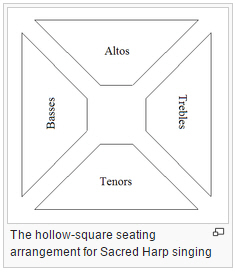
Wikipedia graphic
The Sacred Harp, an a cappella, Protestant-based singing style associated with the Southern United States, has a deep ancestry going back to England’s psalter hymnals and the influence of New England’s “Bay Psalm Book,” but the name, selection of songs, and the method are said to have begun with Benjamin Franklin White and Elisha J. King’s The Sacred Harp, published in 1844.
Tunebooks, as they were called, were also published W. M. Cooper in 1902 and by Seaborn and Thomas Denson in 1936. Singing groups had their favorites as did areas of the country.
Books and Styles
Those who are used to the church hymnals in most protestant churches quickly notice several distinctive differences between the books supplied on the backs of their pews and the Sacred Harp books used at sings: The Sacred Harp books were oblong (landscape format) and feature easily identifiable shape notes to allow people to easily participate without any knowledge of standard musical notation.
While audiences can and do appear at Sacred Harp sings, the singers sing for their own needs and those of their group, all facing inward toward the leader who sets the tempo by raising his arms up and down rather like the conductor of a symphony. Many of the singers, especially those in the honored down-front sections of each section, often duplicate the leader’s arm motions help the group stay synchronized. Many people refer to this as fasola singing.

Sacred Harp is based on old hymns sung the old way. Changes in the music world–gospel and other modern styles, organ or piano accompaniment, stylistic variations of the melody and words–are said to dilute the music. As Buell writes, “The Sacred Harp is–in tone, in musical effect, in the themes the songs focus on–an emotive and yet a disciplined music, austere and uncompromised.”
A Natural End in Itself
In her Beginner’s Guide to Shape-Note Singing, Lisa Grayson points out that the singing is an end itself and that should there be an audience, they are welcome to listen or join in but never applaud any more than they would applaud during a traditional church service, and that the gloomy nature of many of the hymns reflects old church and camp meeting beliefs before some churches turned to “all sweetness and froth.”
While there are never any soloists in Sacred Harp singing, the music emphasizes the human voice which is considered the greatest of all instruments in a natural setting. Many of the hymns contain references to fields, rivers, sky and mountains all of which are considered both natural and sacred.
There are wonderful indexes of Sacred Harp songs available at fasola.org and texasfasola.org which allow you to find tunes by title, first line, composer and meter. To illustrate the so-called gloomy nature, here is “The Weary Souls” written in 1804 as it appears in the Cooper tunebook:
Ye weary, heavy-laden souls,
Who are opprest and sore,
Ye trav’lers thro’ the wilderness
To Canaan’s peaceful shore.
Thro’ chilling winds and beating rains,
And waters deep and cold,
And enemies surrounding us
Take courage and be bold.
Farewell, my brethren in the Lord,
Who are for Canaan bound,
And should we never meet again
’Till Gabriel’s trump shall sound.
I hope that I shall meet you there
On that delightful shore,
In mansions of eternal bliss,
Where parting is no more.
Time and Space
 In her thesis “Journey Into the Square: A Geographical Perspective of Sacred Harp,” Michele Abee writes that “Sacred Harp is a community identified around a common religious practice of a specific type of music. It is a practice that has continually adapted to its space through time and found a unique cultural identity in the American South. The opportunity geography provides Sacred Harp is its ability to define its religious practice according to its time and space. The music itself provides a unique perspective to religious geography as the physical environment represented in the lyrics of the hymns demonstrates that the nature surrounding man is divinely created.”
In her thesis “Journey Into the Square: A Geographical Perspective of Sacred Harp,” Michele Abee writes that “Sacred Harp is a community identified around a common religious practice of a specific type of music. It is a practice that has continually adapted to its space through time and found a unique cultural identity in the American South. The opportunity geography provides Sacred Harp is its ability to define its religious practice according to its time and space. The music itself provides a unique perspective to religious geography as the physical environment represented in the lyrics of the hymns demonstrates that the nature surrounding man is divinely created.”
That’s an apt summary of an approach to worship through music that focuses intentionally on, as Sacred Harp singers see it, “the old road,” while modern churches and modern music have gone far afield through experimentation and creativity onto new roads. Both roads have their attractions. When listened to with an open mind, a Sacred Harp sing can be a powerful experience no matter how modern the listener believes himself or herself to be.
–Malcolm
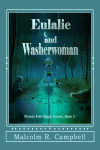 Malcolm R. Campbell’s new novel, “Eulalie and Washerwoman,” features a bit of the culture of of the Sacred Harp, necessitating many enjoyable hours of research into a form of religious singing that is quite different from the Presbyterian tradition the author grew up in.
Malcolm R. Campbell’s new novel, “Eulalie and Washerwoman,” features a bit of the culture of of the Sacred Harp, necessitating many enjoyable hours of research into a form of religious singing that is quite different from the Presbyterian tradition the author grew up in.


October 12, 2016
There are days when I wish I hadn’t logged on to Facebook
We call Facebook social media, but it’s often anti-social media.
It offers us a chance to keep up with people–often old friends we haven’t seen since childhood or college–and to hear about new ideas, general news, books, blog links of interest, and a lot of other things that according to communications theories are supposed to bring various cultural groups and nationalities closer together through enhanced knowledge and understanding of each other.
 I’m not surprised when people use Facebook and Twitter to disseminate facts, ideas and opinions about causes such as the environment, the treatment of women in Muslim countries, military vs. diplomatic methods of resolving conflicts, and the current Presidential race.
I’m not surprised when people use Facebook and Twitter to disseminate facts, ideas and opinions about causes such as the environment, the treatment of women in Muslim countries, military vs. diplomatic methods of resolving conflicts, and the current Presidential race.
In this country, we’re supposed to be champions of free speech. Among other things, that means defending the right of those who express opposing views to express those views. But somehow, that’s all gotten so polarized that people ignore the facts–or don’t spend time looking for them.
What’s changed?
Perhaps nothing, depending on how old you are and what you’ve experienced growing up through many decades of changing priorities and value systems. My feeling is that people aren’t doing their homework. So, when they feel moved to say something on Facebook, they often opt for a graphic or a video prepared by a biased source. Many of the things quoted during the Presidential race either were never said by the candidate or were taken out of context so they appear to mean something quite different than the candidate intended. Yet this stuff is posted as the gospel truth.
As a former journalist and journalism instructor, I not only think many news outlets have gotten warped, but that they are using their agendas to create public opinions that would be much different if those courses were making every effort to be objective. This skewed, highly managed sound bite “journalism” makes its way onto Facebook in all kinds of ways. Truth is the first casualty here. Oddly enough, if you point out to the person who posts a political graphic that the graphic is incorrect, their solution is to believe it anyway. It’s simply easier!
While I almost never post political statements on my Facebook profile, I often “see red” when I see a graphic or a poster’s opinion that twists a real event into something it wasn’t. Even if I say that I heard the speech the person is quoting and that they’re not reporting what s/he said, they don’t care. What they’re posting coincides with their opinions and the facts don’t matter.
Sometimes people ask me what my sources are. When I answer, some people say, “Oh, well I only listen to news sources I agree with.” Ultimate stupidity. You’re not supposed to agree with a source because that source is supposed to be neutral. If they’re not neutral, they’re not a real journalist. I despair when I see the Fox news aficionados and the CNN aficionados screaming at each other about objectivity when both of those news outlets are very biased. Yes, I know, it’s just easier to be led around by a figurative leash by sources who tell you what to think, but that approach hurts all of us.
I know I shouldn’t comment on those kinds of posts, but it’s hard to resist. The result: a lot of time is wasted and nobody’s opinion is changed. What a waste of time.
Malcolm
Malcolm R. Campbell’s new novel “Eulalie and Washerwoman” will be released Friday, October 14th.


October 8, 2016
This and that on a blustery October weekend
Sunshine and gusty weather here in northwest Georgia. Here’s a little this and that:
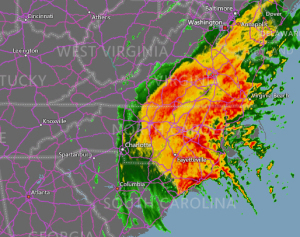 My brother, sister in law, and publisher who live in two counties in central Florida came through the hurricane okay even though they’re still without power.
My brother, sister in law, and publisher who live in two counties in central Florida came through the hurricane okay even though they’re still without power.As you see from the map, I live 275 miles from the Georgia coast. Sure, we have a wind advisory, but not a drop of rain. Meanwhile, my daughter and her family in Maryland will be getting rain soon if it isn’t already there. So, our drought continues while a lot of places have seen way too much water.
The cover art work is done for my upcoming novel Eulalie and Washerwoman. I can’t show it to you yet because my publisher won’t be able to see it until her power comes back on. It looks good. It was done by the same artist who did the artwork for Conjure Woman’s Cat.
While the hurricane was deluging Florida, I was writing a short story about a hurricane. I want you to know what I didn’t use any spells to attract Matthew even though Eulalie loves to whistle up the wind.
I’ve added another poem to the selection in my Kindle stories and poems book College Avenue. When I originally uploaded the book, I couldn’t find a copy of my poem “Sock Puppet.” It first appeared in the former “Smoking Poet” Magazine, but was missing from their archives. Finally, my brother found a copy of it. Thanks, Barry.
Okay, maybe I can show you a little piece of the cover art work, enough to tip you off there’s an alligator in the story:

–Malcolm


October 5, 2016
Authors, do you have expectations of privacy?
“When I first heard yesterday that Elena Ferrante’s legal name may have been revealed, I thought it was because she died. This thought entered my sleepy head in part because I misinterpreted a friend’s tweet on the matter, but also because I couldn’t immediately imagine under what other circumstances that information would come to light. Ferrante is internationally beloved for her novels, especially the Neapolitan series; while I knew some people were unimpressed by her work, I’d heard of no one who wanted to hurt her. Outing her or doxxing her or whatever you might prefer to call it, was so clear and unnecessary a violation that I still can’t see it as anything other than an attempt to do her harm.” – Charlotte Shane in “The Sexist Big Reveal” in “New Republic”
Salinger, Pynchon, Lee, Watterson, and Rowling are among the widely known authors who have guarded their privacy carefully, although their methods have differed. Needless to say, when you have money and are famous, numerous people will seek you out for a variety of reasons, so living at a publicized address on a regular neighborhood street might be out of the question even if that’s the lifestyle you prefer.
Elena Ferrante
Elena Ferrante, who writes under a pseudonym, has been more private than most because her real name has never been divulged–until now if the information about her is correct. The writer who tracked her down and told the world her name has invaded privacy for that appear to be sexist reasons. Her trauma may well be immense, especially if she carries out her promise (made years ago) that she would stop publishing if her real name was revealed.
Author Platforms

Wikipedia photo.
New authors, especially those without major publishing deals and the publicity that comes with them, often approach privacy much differently than those who have achieved popular appeal and critical acclaim. We’re told to establish a platform. In many ways, this platform is who we are and what our specialties are. As for who we are, we’re encouraged to interact with prospective readers on blogs and the social media. Quite often, this means saying how and where we grew up, what kinds of jobs we’ve had, notes about our hobbies and family, and status updates about the slings and arrows of everyday life.
As for our specialties, if we write non-fiction, then we’re asked to establish our credibility in certain fields so that we have potential for article-writing assignments, subject-matter-related interviews, and even questions from the press about issues we might have the credentials to address. The same might occur in fiction if we have expertise in, say, certain areas of history, social issues, police or legal backgrounds, etc. Otherwise, our platform tells prospective readers the kinds of books we like to write and perhaps a little bit about our approach. This establishes us in the minds of prospective readers has an author in the genres they like to read.
Do we say too much?
When invasion of privacy cases reach the courts, one question that’s often asked is, “Did the individual involved have a reasonable expectation of privacy in the area where the alleged invasion of privacy occurred?”
Generally, one doesn’t expect privacy in public areas including one’s own yard that’s visible from the street. The whole business of camera-equipped drones and even satellites is complicating this inasmuch as both of them are capable of producing photographs of people in private backyards that aren’t visible except by air. Conversely, one does expect privacy within their own homes, especially when windows and curtains are kept closed.
Most of us who have talked about ourselves on the Internet and/or in the print media about our experiences and goals as we try to build our author platforms are unlikely to go to court five or ten years later and sue somebody for repeating what we said to the public in a Facebook status update, blog, or interview.
Yet, I often wonder if we say too much. For one thing, we’re competing with famous authors who seldom blab about their daily lives on Facebook. You don’t go to Rowling’s Facebook page and see her posting something about dropping a carton of eggs on her PC keyboard or going to the store for a new dress and not finding anything that fits. Unlike Rowling and others who are widely known, the public is NOT actively trying to find out more about us; also, we don’t have hundreds of events a year to publicize. So, what are we going to say on Facebook and our blogs if we don’t talk about ourselves?
And then, what happens if we become bestselling authors? We’ve pretty much given away the farm on Facebook and blogs if every scrap about our private lives is in print or on line somewhere. Not that we’ve said everything. Even so, do you want a rant you published on your blog 20 years ago on a bad day to be pulled out by critics and “proven” to be the gist of the plot for your latest novel? Probably not.
If our names become household names after we’ve given away the farm while paying our dues and becoming better writers and better known writers, do we have any expectations of privacy once we’re trying to maintain some semblance of a private life? Yes, but it’s going to be more difficult.
The public, and this includes the clown who outed Elena Ferrante, seems to believe that it has a right to know everything about well-known authors, movie stars, and others who are to varying extents in the public eye. Some readers believe an individual’s right to privacy ends the minute they publish a book or star in a film or TV show. Most of us need not lose a lot of sleep about being followed by voyeuristic fans and paparazzi any more than we need to worry about how our lives would change if we suddenly won a $50 million lottery prize.
For all of us who write, privacy is a balancing act. Since bestselling authors don’t write about their plumbing backing up on Monday, burning the steaks on Tuesday, feeling bumbed out about Presidential campaign ads on Wednesday, etc., the fact that newer and/or less widely known authors often do this draws a line between big time writing success and lesser known or unknown authors. That is, to become known, we’re often told we must to the very things a well-known author would never do, and that ends us making us look like amateurs.
On the other hand, we can’t say “buy my book” every day in our blogs and Facebook updates. So, how do we engage with prospective readers? While all of us don’t say everything about our private lives, many of us probably end up saying too much. While we may not want to the privacy of an Elena Ferrante or a Jo Rowling, we might wake up one day and want more privacy than we’ve ended up with.
–Malcolm
Malcolm R. Campbell is the author of “Emily’s Stories” (paperback, audio book, e-book, and Italian/Spanish editions) and “Conjure Woman’s Cat.”


October 2, 2016
Florida Legends – All You Can Eat if You Know How to Find It
Zora Neale Hurston’s “tales from the turpentine camps, on the surface, could be seen as silly, promoting these stereotypes. A sweet potato floating through the air with a knife sticking out of it? Pure fantasy. But a closer reading shows a culture of resistance and resilience. In the camp workers’ wildest dreams, all they want is unlimited access to food, a basic need that often locked them into the camp through debt racked up at the company store, or one that they were sometimes flatly denied. Food was hope and optimism.” – Julie Botnick in “Zora Neale Hurston, Diddy-Dah-Widdy, and the WPA Federal Writers’ Project”
The legendary Florida town called Diddy-Wah-Diddy, collected–or perhaps, imagined–by Zora Neale Hurston in 1938, has been celebrated by numerous blues singers and included in anthologies and re-tellings by Mary E. Lyons and others for years.
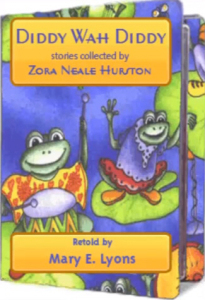 In his New York Times review of The Food of a Younger Land, Jonathan Miles writes, “Couched between a selection of black Mississippi recipes transcribed in dialect (‘wrop cakes in a collard leaf, place on dese coals coverin wid some more hot so hot’) and the Christmas dinner menu at the Brown Hotel in Louisville, Ky., is a stunning prose poem by Zora Neale Hurston about a mythical place in African-American folklore — a kind of barbecue version of Shangri-La — known as ‘Diddy Wah Diddy.'”
In his New York Times review of The Food of a Younger Land, Jonathan Miles writes, “Couched between a selection of black Mississippi recipes transcribed in dialect (‘wrop cakes in a collard leaf, place on dese coals coverin wid some more hot so hot’) and the Christmas dinner menu at the Brown Hotel in Louisville, Ky., is a stunning prose poem by Zora Neale Hurston about a mythical place in African-American folklore — a kind of barbecue version of Shangri-La — known as ‘Diddy Wah Diddy.'”
While the WPA Federal Writers project featuring the story was never completed, Hurston’s work lives on, describing her take on the many dreams of food and better times and magical places from Blacks enslaved in the turpentine camps, usually for minor or imaginary offenses.
Unfortunately, Lyons’ book appears to be out of print. Her website description sounds tempting: “During Virginia’s 2008-2009 Big Read for Little Readers, Mary E. Lyons rewrote these same stories for young people. Now children in grades 1-4 can travel with Zora to a magical land where nobody cooks, but the food is always ready. In Diddy Wah Diddy readers meet Chicken, Pie and Moon Man. They wander to Zar and stroll through Bella. They amble across Amen Avenue, then fly down to West Heck with High John.”
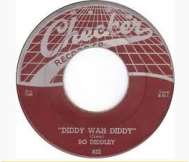 I came across the mythical town while researching Florida legends for my upcoming novel Eulalie and Washerwoman. I couldn’t resist including a reference to the place, a town nobody knows how to get to, but if they happened to find it, all that had to do was sit and wait and pretty soon the best food they could possibly want appeared, ready to eat, with knife, fork and spoon ready to go.
I came across the mythical town while researching Florida legends for my upcoming novel Eulalie and Washerwoman. I couldn’t resist including a reference to the place, a town nobody knows how to get to, but if they happened to find it, all that had to do was sit and wait and pretty soon the best food they could possibly want appeared, ready to eat, with knife, fork and spoon ready to go.
In her collection, Uncle Monday Monday and Other Florida Tales, Kriston G. Congdon’s version includes the line about a town “way off somewhere” that “Is reached by a road that curves so much that a mule pulling a wagon-load of feed can eat off the back of the wagon as he goes.” Congdon says that most people think the place exists.
Perhaps so.
–Malcolm
Malcolm R. Campbell is the author of “Conjure Woman’s Cat,” “The Sun Singer,” and other magical novels. The soon-to-be released “Eulalie and Washerwoman” is a sequel to “Conjure Woman’s Cat.”


September 30, 2016
Yes, I can see forever now (on a clear day)
The last post-op appointment for the cataract surgery in my left eye was today. Doc says come back in a year. Sounds good to me. I was supposed to have this surgery earlier in the year, but ended up having appendicitis surgery on the day it was scheduled. When I was in the hospital for that, they discovered the kidney cancer. But, it was early and the surgery saved me and the kidney with no post-off chemo or anything. A big scar, of course, but unless you’re psychic, you can’t see that.

No, this is not my real eye color.
I resisted cataract surgery for a long time because, quite frankly, I don’t like having surgery. Then people who’d had it said, “You know, you’re awake while they’re doing it.”
Holy crap.
The surgery was very strange. Much stranger than the appendix or the kidney surgery, but without the need for pain pills, nurses, being forced to walk down the hall before they let me out, and all that.
The last time we drove to Memphis to see family prior to the cataract surgery, I was driving and missed some turn-offs because I couldn’t read the signs. My wife said, “It’s time.” Unfortunately, I had to agree with her. Now my vision is close to perfect for distance stuff, walking around the house, knocking over liquor stores and things like that. Cheapo reading glasses are required for reading and using the PC.
I don’t know what the hell any of this has to do with writing other than it’s nice to see what I’m writing. Sure, Beethoven was too deaf to hear his own music late into his life. I can’t imagine the talent it takes to make that work. I really don’t think I want to try writing by displaying the words on my screen at 200%. That’s really tedious, but I was doing that before I had the cataract surgery.
If this post is disjointed, it’s because I’m having a glass of Scotch to celebrate not having to go back to the eye doctor for a year. I’m still trying to figure out if I can see the future without having to get out my Tarot cards.
–Malcolm


September 29, 2016
Returning to Sunetra Gupta’s ‘Memories of Rain’
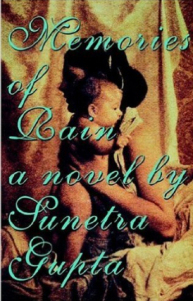 It’s been 24 years since I first read Memories of Rain by Calcutta-born Sunetra Gupta who, when not writing fiction and translating Tagore Poetry, works as a Professor of Theoretical Epidemiology at the University of Oxford. It’s one of my “go to” books whenever I run out of factory fresh books. I’ve read it numerous times and find the prose fresh and new every time I return to it.
It’s been 24 years since I first read Memories of Rain by Calcutta-born Sunetra Gupta who, when not writing fiction and translating Tagore Poetry, works as a Professor of Theoretical Epidemiology at the University of Oxford. It’s one of my “go to” books whenever I run out of factory fresh books. I’ve read it numerous times and find the prose fresh and new every time I return to it.
Moni, who is Bengali, marries an Englishman who, in those early days that began on a rainy day, ignited her passions and promised her everything. Years after that day, Moni is planning to leave him because he not only has another woman, he has brought her into their home in what he sees as a perfect love triangle. Flashbacks tell much of the story.
When the book was released, Kirkus reviews said: “A stunning, luminous debut set in Calcutta and London by a young, true heir to Virginia Woolf. The forward action of Gupta’s hypnotic novel takes place during a single weekend: Calcutta-born Moni, despondent over her English husband’s infidelity, secretly plans to take their daughter and return to India on the child’s sixth birthday. But the stream- of-consciousness narrative weaves together memories and images, providing not just the history of a fragile love but of a woman’s psychology and soul.”
Virginia Woolf is one of my favorite writers, so I was stunned to see such adulation on the back cover of the novel. It turned out to be true, though I wonder how Gupta survived it and was able to write four novels after that one without losing her nerve or her voice. Her most recent is So Good in Black (2011).
Unfortunately, the book is out of print, though you can still find used copies available on Amazon. Several reader reviews on Amazon’s US and UK sites are less than kind, proving my thesis that if you don’t normally read a book in a certain genre, you shouldn’t be writing a review. Such reviewers lambaste the style which is essential to the kind of book it is.
The Independent said, “Do not be put off by this (Kirkus’ viewpoint) – the comparison might have been provoked by the stream-of-consciousness narrative, but Ms Gupta has a refined sensibility and a graceful style all her own. She shows an intelligence, wisdom, and judgement astonishing in so young a writer – she is only 27.”
Ms. Gupta and I have corresponded by e-mail from time to time, and when she came to Georgia for a medical conference several years ago, we planned to meet for a cup of tea. Unfortunately, the conference schedule changed, and we couldn’t make our schedules match. I was one of the early reviewers of So Good in Black and had despaired that it took so long for a U. S. publisher to discover and publish the book, so I expect we might have talked about the book.
Her research of infectious diseases has brought her awards. I marvel at how she juggles two loves, science and art, biology and fiction, and novels that immerse readers in other worlds while she is otherwise focused on the health of this one. Is she Woolf’s heir? Yes and no. If she wrote more fiction, then yes. But since she doesn’t, then probably not. Either way, I think Woolf would appreciate her work.
Perhaps I should hold a seance and talk to Ms. Woolf. Who knows what she would say. Or, if Ms. Gupta comes to Georgia again, perhaps our schedules will match. Meanwhile, I read and re-read Memories of Rain and continue to wonder at its words.
–Malcolm
Malcolm R. Campbell is the author of magical realism and fantasy, including Conjure Woman’s Cat.


September 27, 2016
This and That from, well, me
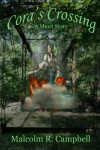 Yes, I’m the guy behind the curtain of this blog. Seemed like it was time for a books update:
Yes, I’m the guy behind the curtain of this blog. Seemed like it was time for a books update:
Two more of my e-books are being translated into Italian, “Cora’s Crossing” and “Moonlight and Ghosts.” Meanwhile, we’be found a translator to create a Spanish edition of “Sarabande.”
The sequel to “Conjure Woman’s Cat,” “Eulalie and Washerwoman” is now on the editor’s desk. (uh oh) I’ve seen a partial version of the cover art and it’s looking good. It’s being done by the by the same artist who did the cover art for the first book.
For years, I’ve put off writing the third book in the Mountain Journeys Series that begins with “The Sun Singer” and then moves forward with “Sarabande.” Don’t laugh, but I didn’t start it sooner because the protagonist knows more about magic than I do, and I thought, “Well, Malcolm, how in the hell are you going to write this book.” I thought about faking it, but that seems wrong. The book’s name will be “Aeon.” Shhh, my publisher doesn’t know about it yet.
My review of “A Girl is a Half-Formed Thing,” which I posted here recently, also appears on Literary Aficionado. Nice to show up on that site again! It’s been a while.
Have you seen this article: How Long Until a Robot Wins the Pulitzer? I don’t think it will happen for a year or two. What about you?
Since this is banned books week, let’s end with a quote about it: “I urge everyone to celebrate Banned Books Week by picking up a book that some closed-minded person out there wanted desperately to keep out of your hands.” – Jessica Herthel
If any of my books are banned, I’ll be really ticked off and might even use some profanity.


September 25, 2016
Review: ‘A Girl is a Half-Formed Thing’
“For you. You’ll soon. You’ll give her name. In the stitches of her skin she’ll hear your say. Mammy me? Yes you. Bounce the bed, I’d say. I’d say that’s what you did. Then lay you down. They cut you round. Wait and hour and day.”
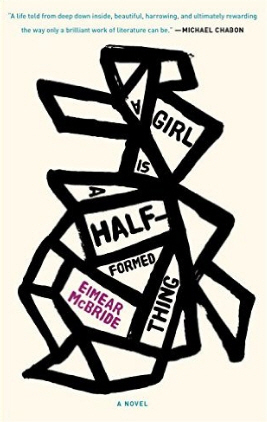 Riverrun of words, past church and family and worse, from swerve of hope to bend of knee, you might think you’re reading “Finnegan” again as you start Eimear McBride’s streamOFconsciousness novel A Girl is a Half-Formed Thing. James Joyce leaves early on, though when you reach the novel’s final words, you might agree this story is a wake.
Riverrun of words, past church and family and worse, from swerve of hope to bend of knee, you might think you’re reading “Finnegan” again as you start Eimear McBride’s streamOFconsciousness novel A Girl is a Half-Formed Thing. James Joyce leaves early on, though when you reach the novel’s final words, you might agree this story is a wake.
It’s also a mental letter of sorts, an interior monologue, from a rebellious sister to a brother with a brain tumor, within.the.tight.confines of a dysfunctional household, abuse and other perversions, rape and WorseThanRape, and the protagonist’s desperately destructive behavior. We are INside her head. Too much for simple syntax there, though sin is a constant theme, and prayers, too, so when James Joyce leaves the book by the back door, Virginia Woolf arrives at the front door. Figuratively speaking. You should be afraid, for this book will wreck you as though you yourself are violating the protagonist page by heartbreaking page, you bastard.
It’s also a raw poem, laced with the worst muck of life, the flotsam any free-flowing river carries along with sunlit ripples of lyr(within lyrics)ics more beautiful than anyone other than the doomed brother deserves to hear. The flow of words, blood, semen, vomit and other prayers are dAZZling to experience. The book’s un-named characters lead sad lives that would be sad if McBride had told the story through a conventional approach. Yet the fractured prose fits all that’s broken in the story and the poetry of the riverrun of words accentuates every vile UNformed and 1/2Formed thing.
Mammy is a single parent who is randomly holy.past.all.understanding, loving, vicious, and blind to everything but her son in her unkempt house in this small Irish town. Daddy is absent, resting in hell or elsewhere. Uncle is perverted. Schoolkids are cruel. Men have one thing on their minds. Brother is slow. Sister is wantonly searching for herself. And fate is relentless. Life inside this story, and inside the protagonist’s head, is difficult, difficult to read in half-formed thoughts, and impossible to set aside.
You won’t forget this story even though you will try.
–Malcolm





